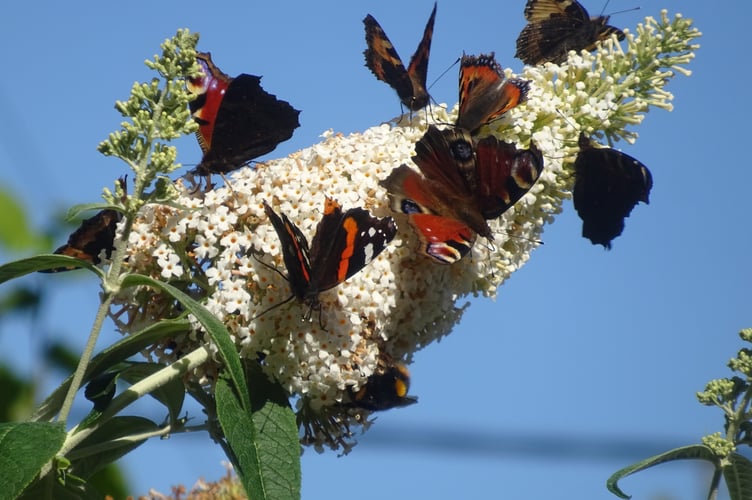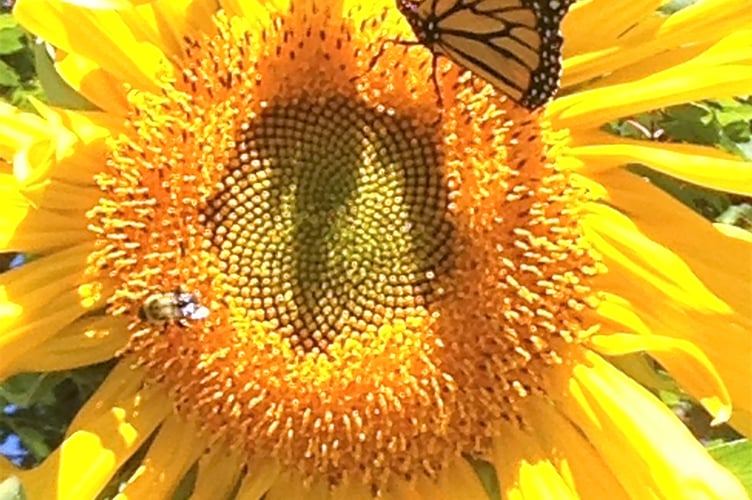BUTTERFLIES, one of the joys of summer, are fast disappearing from our gardens. The good news is that it’s not difficult to make butterflies welcome - and now’s the time to think about choosing a range the plants that will attract them.
According to the charity Butterfly Conservation, 75 per cent of native species have seriously declined in the past ten years. But there’s no reason why you can’t create a colourful flutter in your garden - however small it may be - by offering an inviting variety of nectar-rich plants.
It’s nectar that provides butterflies and moths with the energy to fly, to find a mate and to refuel after winter hibernation.
Butterfly caterpillars feed on leaves and flower buds of so-called 'caterpillar food plants' which are mostly what we regards as weeds - nettles, buckthorn, docks, plantains, dandelions and brambles. These will flourish on any bit of spare ground you allow to go back to nature.
Ivy in a sunny position is a favourite with several varieties of butterfly, including the common brimstone, and the red admiral. The flowering umbels are a rich nectar source and the foliage provides cosy winter hibernating sites.
Now is the time to include butterfly favourites in your 2025 planting schedule, beginning with early-flowering plants such as crocuses, arabis and aubretia.
As the year progresses, plants like honesty and buddleia - actually known as “the butterfly bush” - should bring some welcome visitors to your garden, including red admirals, peacocks and small tortoiseshell.
There are at least 12 varieties of buddleia and a friend once counted a total of 53 peacock butterflies on one bush at the same time. By cutting off the “spikes” as soon as they start to wither the flowering period can be lengthened and I have seen speckled wood butterflies on buddleia flowers as late at October, as well as graylings and swallowtails.
Red valerian, verbena, sedum, hebe, wild majoram and common knapweed should guarantee visits from a good number of the 20 or so butterfly species that we are lucky have in West Somerset and on Exmoor.
Lavender attracts many species and so do herbs, especially mint, marjoram and thyme. Mustard is easy to grow and will bring several butterfly species including the common blue, which will use the stalks as roosting sites. Remember that the flowers of some vegetables are also good butterfly attractors, especially runner beans.

When planning your summer flower displays for next year, why not include butterfly favourites like sweet William, phlox, marigold, sunflowers and candytuft. And late-flowering erigeron and Michaelmas daisies can attract butterflies right into November, particularly in our usually-mild West Somerset climate.
If you leave lawns uncut for a week or two, the resulting flowers will attract butterflies such as skippers and small coppers. Leave windfall fruit to rot on the ground and you are likely to get red admirals and commas feasting on the juice.
If you live deep in the countryside, you could be fortunate enough to get rare visitors which are attracted to woodland and uncultivated grass and moorland.
This year, a friend in an Exmoor village saw heath fritillaries, only introduced to the area only a few years ago, and a large blue, actually extinct until revived in the 1980s.
This year there has been an abundance of large cabbage white butterflies and it’s hard not to enjoy the sight of them fluttering busily among the flowers. But as anyone, like me, who has suffered a brassica massacre this year knows, there’s absolutely nothing to enjoy about their wretched caterpillars…

JUST THE JOB
What to do in West Somerset gardens in October
We can enjoy the remains of summer for up to a month longer than gardeners further north, but October weather can still be unpredictable, so take advantage of fine spells to get on with soil preparation and planting bulbs, trees and shrubs.
CUTTINGS
Evergreen shrubs, gooseberries, currants and woody herbs such as lavender, will all form roots over the winter from cuttings taken now. Set them in a gritty compost mixture in pots in an unheated greenhouse or cold frame, or in a slit trench in a sheltered position outside.
Fruit bushes can also be propagated by layering. Take a low-growing shoot of this year’s wood and pin it to the ground. In spring when roots are established, cut from the parent plant and transplant.
Well established border plants will benefit from splitting. Replant in compost to give them a good start over the winter
PLANTING
Now is the time to plant bushes and trees of all sorts - except conifers. This includes fruit, roses and hedging plants, Prepare the hole thoroughly with well-rotted manure or compost and a handful of bonemeal.
When staking new plants liable to wind-rock, put in a stake before planting to avoid root damage.
HARVESTING
When beans and peas have finished cropping, simply cut the plant away at ground level, leaving the roots in the soil. They will slowly release nitrogen as the roots break down.
Harvest squashes and pumpkins before the first frosts. They quickly turn mushy if left outside.
When harvesting cabbages, leave the root in the ground and make a cut across the stem to encourage a flush of smaller leaves for winter picking.
Maincrop apples should be ready about now - remember to lift not pull when picking. Store in trays in a frost-free building.
BEDS AND BORDERS
Lift dahlia and begonia tubers and gladioli corms to store in a dry place over the winter.
Prune climbing and rambling roses once they’ve finished flowering and tie in the stems against autumn winds.
Cut back perennial plants which have died down and clear up fallen rose leaves to prevent diseases such as black spot from overwintering.
After tidying borders, mulch with bark chips, well-rotted manure, leaf-mould or spent mushroom compost to insulate plants for the winter and keep weed growth in check.




